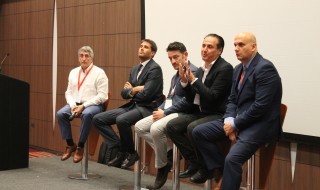
Nojan Khalehoghli reports back from Endodontic Skills Development Day 2016, held at the Ilec Conference Centre in London in July
With an international line-up of speakers headed by Dr Julian Webber, the main themes of Endodontic Skills Development Day 2016 included simplified canal preparation with recently developed mechanical nickel titanium instruments, and more effective decontamination with emphasis on preservation of tooth structure.
Evolution of nickel titanium shaping
Dr Webber started the proceedings by presenting an overview of the evolution of nickel titanium mechanical shaping instruments. Since their inception, mechanical nickel titanium instruments have simplified canal preparation with fewer procedural errors and more predictability due to their favourable mechanical properties, namely those of higher flexibility than stainless steel, and super-elasticity – the ability to recover their original shape upon unloading.
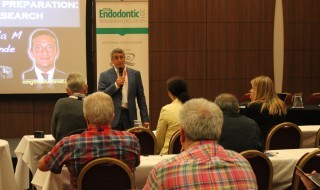
Over the past two decades, a wide range of nickel titanium instruments have been introduced, with each new system aiming to improve upon the performance of previous ones, however, preparation errors still occur.
As with stainless steel instruments in the past, manufacturers have tried to modify the behaviour of mechanical nickel titanium instruments by altering certain elements of their design, such as cross-sectional geometry, flute shape, angulation and tip configuration etc. In recent years, manufacturers have tried to improve the mechanical properties of instruments by a variety of surface treatments and alterations of the proportional composition of the different crystalline phases found in nickel titanium alloy through thermomechanical processing.
Dr Webber was strongly in favour of initial canal scouting and enlargement for all nickel titanium systems, both rotary and reciprocating
A new generation of nickel titanium instruments introduced in 2007 and made from M-Wire include GTX, Waveone and Protaper Next (Dentsply Sirona) and Twisted Files (Sybron Endo) made from ‘R’ phase nickel titanium alloys. These files show improved fracture resistance and flexibility compared to instruments made from conventionally processed super-elastic nickel titanium alloy. Dr Webber discussed the design features and clinical protocol of the recently introduced Waveone Gold and Protaper Gold systems in some detail.
Dr Webber was strongly in favour of initial canal scouting and enlargement for all nickel titanium systems, both rotary and reciprocating. A glide path is established using small size stainless steel hand instruments until a size 10 hand file is ‘super loose’ to apical patency at working length. This glide path can be further enhanced and captured using the Proglider from Dentsply Sirona.
Dr Webber proposed that once a glide path has been established, most cases with moderate to severe curvatures can be completed using a single Waveone Gold primary file. If the primary file is unable to reach working length despite a confirmed, secured and reproducible glide path, then the Waveone Gold small is used followed by the primary. Conversely, if the naturally occurring canal size is larger than the primary, the medium or the large Waveone Gold file is used to complete the shaping.
Negotiating the ‘unscoutable’
Internationally renowned speakers Dr Nicola M Grande and Dr Gianluca Plotino focused on simplifying canal preparation by concentrating on reciprocation as the mode of manipulation of nickel titanium instruments.
First described by Dr Ghassan Yared in 2008, and using an F2 Protaper Universal rotary file, the concept of unequal angles of forward and backward movement was further developed to create Waveone and Reciproc (VDW) systems both made from M-Wire nickel titanium alloy, with a left-handed angulation of the blade cutting in a counter clockwise direction.
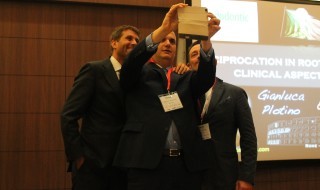
The reciprocating movement is composed of a 150-degree rotation in the cutting direction, advancing the file in the canal with little or no apical pressure followed by a 30-degree disengaging clockwise rotation. The magnitude of the angle for each rotational component is specially selected to be smaller than those at which the elastic limit of the file is exceeded, thus reducing risk of instrument binding and fracture.
Dr Plotino and Dr Grande proposed that Reciproc was the only true ‘one file’ system available that was capable of completing the whole preparation from start to finish with one rotary instrument following the path of least resistance without the need for initial canal enlargement or ‘glide path’. The simplicity of the Reciproc system means that it has a reduced learning curve and is more time and cost-effective for the busy clinician.
Dr Plotino and Dr Grande analysed closed system motors as being safer than the open system motors
Although both continuous rotation and reciprocation can prepare canals optimally, the speakers reported that their own research had shown Reciproc to be less prone to cyclic fatigue (the main cause of instrument fracture), to have greater cutting efficiency and follow the original anatomy more closely, creating better centered preparation.
Dr Plotino and Dr Grande analysed closed system motors (where variables are optimally fixed) as being safer than the open system motors (where the variables can be altered by the clinician) and hybrid motors such as TF Adaptive (Sybron Endo) where continuous rotation automatically changes to reciprocation when resistance is met.
A novel approach
Safe negotiation of severely curved and anatomically complex root canals has traditionally been accomplished by increased coronal flaring for improved access to the apical parts and creation of smaller apical preparations, thus reducing risk of transportation and instrument separation.

This approach, however, has certain inherent disadvantages. Larger coronal preparations risk excessive removal of sound root dentine, weakening the tooth structure, and smaller apical preparations might compromise delivery of irrigants and medicaments preventing adequate decontamination of these parts. With conventional nickel titanium rotaries, repeated engagement of canal walls leads to build-up of torsional and cyclic fatigue, weakening the file and packing of debris in to the flutes reduces cutting efficiency.
To minimise the aforementioned undesirable effects, Dr Antonis Chaniotis of the University of Athens proposed a preparation sequence named ‘tactile controlled activation’, which aims to restrict the length of active canal engagement of rotary files to one insertion or stroke at a time. It is used in combination with the clinician’s tactile sensory feedback. Although the technique can be used with all rotary systems, martensitic files tend to follow the original anatomy more closely, especially in cases of increased anatomical complexity.
Martensitic files tend to follow the original anatomy more closely, especially in cases of increased anatomical complexity
Dr Chaniotis illustrated the technique in detail using Hyflex EDM files (Coltene), which are produced by a combination of thermomechanical treatment and electrical discharge machining (EDM) producing instruments with increased flexibility, fatigue resistance and surface hardness. He was of the opinion that by maintaining tactile sensory feedback throughout the preparation sequence, even the most challenging anatomical variations can be safely and quickly negotiated and enlarged, and that in 75% of cases canal preparation can be completed using a single Hyflex EDM size 25 file.
Less taper, larger apical sizes
Professor Gianluca Gambarini described ‘minimally invasive endodontic’ as the conceptual expression of minimising structural changes during endodontic treatment, by preserving as much sound tissue as possible and not weakening teeth unnecessarily.
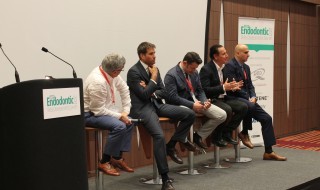
Optimal access cavity configuration is vital to the long-term success of the final restoration and the clinician must try to prepare a purposefully crafted minimal access with consideration given to the future functioning of treated teeth. It is desirable to preserve maximum amount of circumferential dentine compatible with adequate decontamination of the main canal spaces.
Often a compromise has to be reached between the need for effective microbial control and preserving the structural integrity of treated teeth
Professor Gambarini suggested that large increases in taper of preparations are generally not needed for adequate disinfection of the apical parts and recommended the use of smaller, more flexible and less tapered instruments, eg, 0.04 taper, with shorter cutting blades in an anatomically led or driven fashion. Further enlargement of canal spaces both apical and coronal can be accomplished more safely and conservatively by circumferential brushing of canal walls with the same smaller taper instruments instead of using the next larger file. Often a compromise has to be reached between the need for effective microbial control and preserving the structural integrity of treated teeth.
Become an activist!
The biological objectives of endodontic treatment require reduction of the microbial load to a less or non-pathogenic level using instruments and irrigants, ie, disinfectants and intracanal medicaments. As technological developments continue to improve instrument performance and simplify preparation procedures, more time and resources can be dedicated to achieving more effective disinfection by better debridement rather than enlargement of canal spaces by:
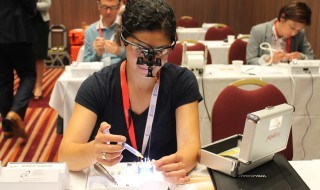
- Activation of irrigants including chemicals used for removal of smear layer, eg, EDTA, citric acid, should be considered a fundamental part of decontamination protocols since our current best preparation techniques do not clean and shape the hidden lateral anatomy, which greatly increases in complexity in roots with more than one canal
- Maximise contact between files and canal walls. Using the analogy of cleaning a table, Professor Gambarini illustrated that effective disinfection of surfaces requires a combination of a cleaning agent and application of pressure. The same principle holds true for effective decontamination of canal walls, which can be accomplished by circumferential brushing especially important in oval canals. A combination of obturation techniques can then be used to fill the prepared spaces.
At the end of his presentation Professor Gamabrini briefly described the features of the Sonicfill (Kerr) posterior composite system, where application of sonic energy dramatically reduces viscosity of the material reducing voids, allowing close adaptation to bonded surfaces.
The day turned out to be enjoyable and informative, not to be missed by endodontic aficionados
Tour de force
Following a lively Q&A session, the evening programme continued with live interactive presentations and hands-on sessions. The day turned out to be an enjoyable and informative tour de force of recent technological and conceptual developments not to be missed by endodontic aficionados.
I think I will be back next year!


